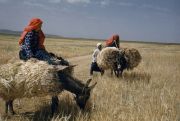Ephah
The ephah (Hebrew אפה) is a unit of dry measure equal to one-tenth of a chomer and 10 omers. It is roughly equivalent to 5.75 gallons or 22 liters. The bath is the same size as the ephah, but holds liquids. Clay vessels that held an ephah were typically cylindrical jars that measured one cubit across and down, or 4 palms high by 3 palms across (or vice versa).
Etymology
The word “ephah” comes from the Hebrew “aphah”, meaning “to bake”. Presumably then, this was the amount of bread baked in one batch. Since there are 10 omers in an ephah, the omer then, logically, would be equivalent to one loaf of bread.
Sheaves
When sheaves are bundled, they are usually stacked into “stooks” to dry. They seem to average around 10 bundles each, based on the pictures and information I can find online. If more are added, the ones in the middle don’t dry properly; if there are fewer of them, they fall over in the wind. Thus, each one of these stacks would yield ten omers, or one ephah of grain.
The picture at right of wheat bundles being carried on a donkey’s side probably had one ephah on each side of the donkey, with a woman on top. It makes a handy size as a bundle – again a reason to have it be a unit. These ephah-bundles were then hauled to the threshing floor, where they were piled in a heap, and oxen or donkeys dragged a scraper over the grain to separate the wheat from the chaff.
So an ephah is the size of the stacks of wheat, and the size of the bundles of unshelled grain carried on a donkey. It is also the amount of grain required to seed an acre, which is the amount of land a yoke of oxen can plow in a day, and is enclosed by a square of 100 cubits in length – which is exactly 100 steps, or 100 arm lengths, each of which is composed of 7 hands. And one hand can carry an ephah comfortably.
A Symbol Of The Ephah
To explain the symbolism of the ephah, I have to digress a little bit first. Paul tells us the manna was placed in a pot made of gold.[1] And that omer was placed inside of another, larger container – a “jar”.[2]
This looks like two separate containers, one placed inside of the other: “fill an omer”, then put that container inside a larger pot. Logically, if it is indeed two bowls it would have to be an omer inside of an ephah inside of the ark. What other sized “pot” would there be?
But why have one vessel inside of another? The ark, at least at that time, was moved regularly, carried by hand. If the omer was heaped up and running over, then the outer pot would have held the leftovers – the “crumbs” (of bread) that fell from the master’s table (Matthew 15:27).
Zechariah 5:6-8 ...And he said, This is an ephah that goeth forth. He said moreover, This is their resemblance through all the earth. And, behold, there was lifted up a talent of lead: and this is a woman that sitteth in the midst of the ephah. And he said, This is wickedness. And he cast it into the midst of the ephah; and he cast the weight of lead upon the mouth thereof.
This shows a clear precedent for putting an omer-talent inside an ephah, just as was done in the ark. In this symbol, a wicked woman is pictured as “sitting in the midst of the ephah”. This can only be the great whore who sitteth upon many waters – the nations of the Earth.
So when it says this ephah is “their resemblance through all the Earth”, what it’s saying is that the ephah pictures the Earth. But what’s more, she is is portrayed as lead – a talent or loaf of lead. Equal in weight to the talent of gold the candlestick was made of, equal in volume to the bowl of manna which was also put inside an ephah.
Lead is a very good imitator of silver; very similar in weight, very similar in appearance. The main difference is that lead corrodes much easier and is much softer. Lead bricks with gold on the outside also make a good counterfeit for gold, as lead is heavy enough to fool someone who isn’t familiar with the true weight of gold.
So lead can deceive people into believing it is either the silver talent, or the golden talent. So if the false church is portrayed by a talent of lead within the Earth, then the true church would be portrayed as a talent of gold or silver, or a talent of bread. Like the one within the other ephah.
Bread pictures the literal body of Christ, and the church, His spiritual body.Thus the omer in the ark, full of a talent of manna, pictures the true church/Israel. That way, the crumbs of the spirit of God that fall from the table of Israel are not lost, but fall in the Earth where the Gentiles find them.

